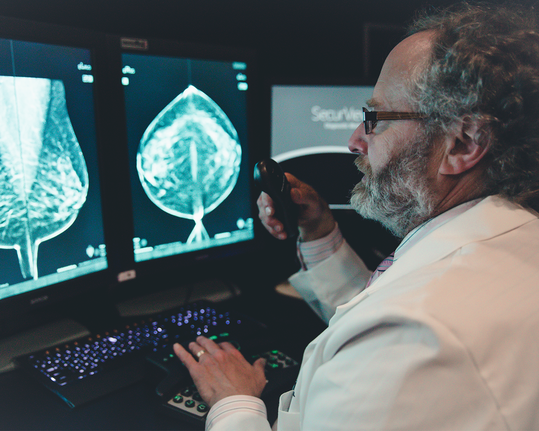At UC Health, we lead the region in scientific discoveries and embrace a spirit of purpose – offering our patients and their families something beyond everyday healthcare. At UC Health, we offer hope.

Breast Imaging
Our breast imaging experts focus solely on breast-related screenings and diagnosis. We offer experienced, deeply compassionate and personalized care.
Call for more information or to schedule an appointment.
At UC Health, our breast imaging radiologists take the time to look at the whole picture—the one beyond the screen. We consider risk factors, including medical and family history, studying and interpreting every detail of your breast tissue. We stay on top of the latest innovations in the field. In fact, we discover many of them. And, if there are any abnormalities, we work closely with a team of experts in breast health to chart the best path forward for you.

Breast Imaging Services We Offer
As the only regional facility with dedicated breast imaging experts, we are leading the way for top-notch breast care.
- 3D Mammography (Tomosynthesis)
- Abbreviated Breast MRI (AB-MRI)
- Breast Biopsy
- Breast Ultrasound
- Diagnostic Mammogram
- FAST MRI
- Magnetic Resonance Imaging (Breast MRI)
Meeting You Where You Are
Screening Mammograms Made Easy
Your annual mammogram is an important part of your overall health. With convenient and comprehensive options, UC Health makes it easy to put your health first. Schedule your mammogram by calling 513-584-PINK or visit our mobile mammography van throughout the city.

OUR UNIQUE APPROACH
Invested In Science. Invested In You.
At UC Health, we’re known for turning the latest scientific discoveries into care you can receive today, and that’s just as true for our breast imaging services. We’re pioneering new and exciting studies, like identifying breast cancer in women before symptoms appear. Our Breast Center is a double-accredited center—meaning you always have access to the latest, evidence-based care. Most importantly, we are dedicated to empowering you to make the best choice for your breast health.
AUTHORING BREAKTHROUGHS
Reimagining the future of breast care
Leading- Edge Technology
We’re bringing groundbreaking care to you. Smart clip localization pinpoints abnormal breast tissue to remove— - leading to a more comfortable experience and cleaner margins.
Setting the Standard in Care
We don’t just deliver innovative care, we create it. Our colleagues and patients participate in research and clinical trials that improve and inform breast cancer screenings.
Putting a Team on Your Side
Here, renowned breast oncologists, surgeons and radiologists collaborate together to develop a personalized care plan—created just for you.
Our Providers
No physicians found.
HOW YOU CAN CONTRIBUTE
Donations from people like you make the difference.
By advancing medicine, our life-changing research and treatments help countless patients here and around the world. Please donate today.

